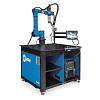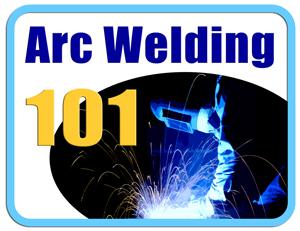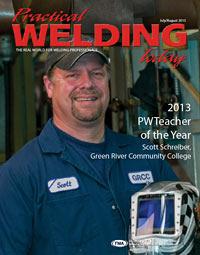- FMA
- The Fabricator
- FABTECH
- Canadian Metalworking
Categories
- Additive Manufacturing
- Aluminum Welding
- Arc Welding
- Assembly and Joining
- Automation and Robotics
- Bending and Forming
- Consumables
- Cutting and Weld Prep
- Electric Vehicles
- En Español
- Finishing
- Hydroforming
- Laser Cutting
- Laser Welding
- Machining
- Manufacturing Software
- Materials Handling
- Metals/Materials
- Oxyfuel Cutting
- Plasma Cutting
- Power Tools
- Punching and Other Holemaking
- Roll Forming
- Safety
- Sawing
- Shearing
- Shop Management
- Testing and Measuring
- Tube and Pipe Fabrication
- Tube and Pipe Production
- Waterjet Cutting
Industry Directory
Webcasts
Podcasts
FAB 40
Advertise
Subscribe
Account Login
Search
Arc Welding 101: Finding clues in the AWS D1.1 Commentary
- By Paul Cameron
- April 24, 2014
- Article
- Arc Welding
Q:The company that I work for makes a single-pass circumferential weld on which there is a minor tendency for an open pore in the weld crater at the tie-in. Our engineering department deems this weld discontinuity as a cosmetic issue only and thereby has authorized the use of a sealant.
In the 2010 version of the AWS D1.1 code, the Commentary paragraph C-5.28 states that if all inspections of weld and base metal have been completed and accepted prior to application, a nonmetallic filler or mastic may be used for cosmetic reasons.
Is our application consistent with the intent of this paragraph in the commentary, or is it referring to something different?
Anonymous
A: I can’t tell you how good it makes me feel that you would explore the Commentary to learn more about the code’s intent. That’s what the Commentaries are there for.
Your interpretation on the use of fillers in this situation is correct. If your engineers have deemed this discontinuity to be acceptable, then the use of fillers is a good way to enhance the look of this surface. And, yes, you are still within the guidelines of AWS D1.1.
I implemented this same repair recently for a local manufacturer. Their old way of doing business was to take a GMAW gun to these pinholes and “zap” weld into them. This version of the repair turned a perfectly acceptable discontinuity into an arc strike—a big no-no in the wonderful world of welding.There is risk with this practice. The last thing you want to do is to use that same filler on unacceptable defects. Using fillers to mask unacceptable undercut, overlap, or porosity (pinholes) would be disastrous. So be sure to monitor this practice closely.
I’m glad you opted for the Bondo over the arc strike, and I’m glad you turned to the Commentary to understand the code’s intent.
About the Author

Paul Cameron
Braun Intertec
4210 Highway 14 East
Rochester, MN 55904
About the Publication
subscribe now

The Welder, formerly known as Practical Welding Today, is a showcase of the real people who make the products we use and work with every day. This magazine has served the welding community in North America well for more than 20 years.
start your free subscription- Stay connected from anywhere

Easily access valuable industry resources now with full access to the digital edition of The Fabricator.

Easily access valuable industry resources now with full access to the digital edition of The Welder.

Easily access valuable industry resources now with full access to the digital edition of The Tube and Pipe Journal.
- Podcasting
- Podcast:
- The Fabricator Podcast
- Published:
- 04/30/2024
- Running Time:
- 53:00
Seth Feldman of Iowa-based Wertzbaugher Services joins The Fabricator Podcast to offer his take as a Gen Zer...
- Trending Articles
Aluminum MIG wires offer smooth feeding, reduced tangling

The role of flux in submerged arc welding performance

Three ESAB welding machines win Red Dot Awards for product design

Power source added to cobot welding system for simplified automation

Connecticut students compete in Maritime Welding Competition

- Industry Events
Pipe and Tube Conference
- May 21 - 22, 2024
- Omaha, NE
World-Class Roll Forming Workshop
- June 5 - 6, 2024
- Louisville, KY
Advanced Laser Application Workshop
- June 25 - 27, 2024
- Novi, MI
Precision Press Brake Certificate Course
- July 31 - August 1, 2024
- Elgin,



























